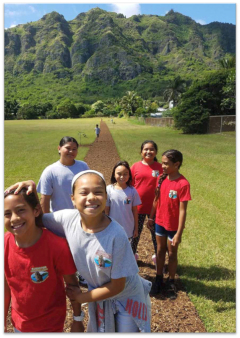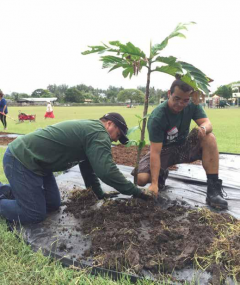Growing health and wellness through agroforestry
Guest post from Hawaii’s Kaulunani Urban and Community Forestry Program in coordination with the Western Urban and Community Forestry Network's #HealthyTreesHealthyLives social media campaign. Explore the hashtag #HealthyTreesHealthyLives on social media to learn more.

Blanche Pope Elementary School is a small rural school serving a native Hawaiian Homestead community in the town of Waimānalo, Oʻahu. The school and broader community are strongly grounded in Hawaiian culture, which values growing food on their land for subsistence.
To improve the health and wellbeing of students and staff, the school initiated a weekly walk around the campus. To support this effort, they applied for an urban forestry community cost-share grant to install an 800 foot-long pathway around the campus shaded by trees, and including exercise stations to create a complete "fitness circuit.” The pathway design incorporated breadfruit (Artocarpus altilis), trees (`ulu) every 100 feet, so walkers and runners could measure their progress. `Ulu, which means “to grow, to spread out” in Hawaiian, makes it a natural choice for their tree planting project. `Ulu trees grow into tall shade trees and are a highly nutritious food source, popular across the Pacific. In addition to being a source of physical sustenance, the tree is also a source of cultural sustenance with multiple medicinal and textile uses, for example its bark is used to make barkcloth and its sap can be used as a glue for gourds or to seal canoes. Additional fruit and food trees such as banana, papaya, mango, coconut, and citrus were planted along the pathway and perimeter of school as part of a “food forest,” which can supplement the nutritional needs of the students and families. With 67% of the school’s students eligible for free/reduced lunches, this project meets an important need in the school and community.

The grant also provided shade to playground areas and the school frontage sidewalk as well as shaded spaces for outdoor learning activities enabling the students to regularly experience the benefits of a greener campus. Benefits for improved learning outcomes, attention and wellness are well documented in literature.
One of the main outcomes of this project is in involving the surrounding community in "fruit tree care days" to harvest the fruits and do periodic tree maintenance. This enables the benefits of food, exercise, shade and health to spill over into the community.
Students have directly benefited from this project through ongoing engagement during the school day and after-school stewardship programs including a gardening club which also maintains a vegetable garden and “sponge” garden to treat stormwater runoff. These students and their teacher readily share their pride with visitors as Ambassadors for the project.
To learn more, please contact Jolie Wanger.
Photo Credit: Alberto Ricordi